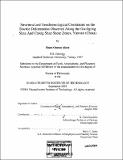Structure and geochronological constraints on the ductile deformation observed along the Gaoligong Shan and Chong Shan Shear Zones, Yunnan (China)
Author(s)
Akciz, Sinan Osman, 1974-
DownloadFull printable version (23.06Mb)
Alternative title
Structure and geochronological constraints on the ductile deformation observed along the GSSZ and CSSZ, Yunnan, China
Other Contributors
Massachusetts Institute of Technology. Dept. of Earth, Atmospheric, and Planetary Sciences.
Advisor
B. Clark Burchfiel.
Terms of use
Metadata
Show full item recordAbstract
The mechanism by which the Cenozoic post-collisional northward motion of India relative to Eurasia and South China was accommodated along its eastern boundary is still a poorly understood aspect of the tectonic evolution of SE Asia. This thesis focuses on a critically important area within the India-Eurasia collision zone, a region known as the Three Rivers area, and presents the first structural and geochronological data from several transects across two poorly documented linear metamorphic belts located in between the Sagaing fault and the Ailao Shan Shear Zone: the Gaoligong Shan Shear Zone (GSSZ) and the Chong Shan Shear Zone (CSSZ) in Yunnan, China. The presently inactive GSSZ is an important dextral Cenozoic (and possibly latest Mesozoic) ductile shear zone and appears to be the only right-lateral shear zone with the appropriate orientation to accommodate major pre- ca. 11 Ma northward movement of India relative to Eurasia. The previously unknown CSSZ is a long (>300 km) and wide (10- 20 km) metamorphic belt containing an assemblage low- to high-grade rocks from possibly several tectonic units which contain a prominent sub-vertical foliation and a sub-horizontal stretching lineation. Preliminary U/Pb results indicate that the ductile dextral shearing terminated by -18 Ma. Our regional map compilations indicate that the GSSZ and its proposed conjugate, the ASSZ, likely terminate within the Bangong Co-Nujiang suture zone. (cont.) This thesis documents the dextral GSSZ as the conjugate pair to the sinistral ASSZ, and thus constrains the limits of the crustal fragments that extruded to the southeast. Based on our reinterpretations of the geological maps of Tibet and the Three Rivers area, however, we propose that the extruded crustal material originated east of the easternmost corner of the Indian indentor, and did not create space for the penetration of India;. while at least limited extrusion did occur, there is no compelling geological evidence to indicate large-scale eastward movement of crustal material from directly north of the India indentor. Data presented in this thesis also indicate that extruded region was dismembered into at least two major crustal fragments, separated by the CSSZ.
Description
Thesis (Ph. D.)--Massachusetts Institute of Technology, Dept. of Earth, Atmospheric, and Planetary Sciences, September 2004. Some pages folded. Includes bibliographical references.
Date issued
2004Department
Massachusetts Institute of Technology. Department of Earth, Atmospheric, and Planetary SciencesPublisher
Massachusetts Institute of Technology
Keywords
Earth, Atmospheric, and Planetary Sciences.